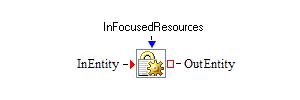
The Seize block obtains resource entities from resource holding blocks (for example, Resource Pool blocks) and allocates them to a controlling entity. The controlling entity must have acquired all the required resources before it can pass through the Seize block.
The required resources are specified by one or more resource constraints. Each resource constraint is defined in the Seize block’s Constraints properties dialog box table and is associated with an input resource entity port on the block. The input resource ports are meant to be connected to resource holding blocks. When a controlling entity attempts to enter a Seize block, the resource constraints associated with all resource ports are checked for availability. If all needed resources are available, they are pulled from the resource input ports and allocated to the controlling entity. If any of the resource constraints cannot be satisfied, the controlling entity is not allowed to enter the block.
The Input Variables table can be used to define variables that can be used in the Constraints table.
The InFocusedResources port, if connected, can be used to provide a reference group of resource entities as the initial set of the resources to be examined and seized from resource input ports. If no qualified resources are found among these focused resources to satisfy a resource constraint, the Seize block attempts to look for other resources to seize from the resource holder blocks connected to the input resource entity ports.
- InEntity
-
Input entity port for entering controlling entities.
- OutEntity
-
Output entity port for exiting controlling entities.
- InFocusedResources
-
Input entity group port for pulling the references of a group of resource entities to be used as initial resource entity candidates to seize from the resource input ports.
The Input Variables dialog box enables you to specify the table entries for input variables. Variables defined in the Input Variables table can be used to define constraints in the Constraints table.
- Add
-
Adds a new input variable (with a default name) to the Input Variables table and creates a new input value port on the Seize block. Each field of an input variable can be edited directly in the table.
-
The Name field of the entry specifies the name of the variable and the name of its associated input port. You can use the input port during the simulation execution to dynamically assign a value to the input variable. For example, an Extractor block could be connected to the input port to extract an attribute from the controlling entity to be used as the value of the input variable.
-
The ValueType field specifies the input variable value type. The type can be number, string, or Boolean.
-
The optional Default Value field specifies the value that will be used in the case where there is no connection to the input port associated with the variable.
-
- Remove
-
Deletes an input variable that has been selected from the Input Variables table.
The Constraints dialog box enables you to specify the table entries for input resource entity ports and associated resource constraints.
- Add
-
Adds a new resource port (with default values for its fields) to the Constraints table. Each field can be edited directly in the table.
-
The PortName field of the entry is the name of the input resource entity port to use when attempting to seize a resource entity for use by a controlling entity.
-
The Units field specifies the desired amount of resource units in the resource to be seized using the port. Its default value is 1. If the Units field is left blank, a numeric port is created, from which the Seize block dynamically pulls the units value for the current controlling entity during simulation.
-
The Separable flag indicates whether the needed resource units can be provided by two or more resource entities jointly.
-
The optional Attributes field can be used to specify a Boolean expression that includes attribute values for the targeted resource entities. You can type the expression in the Attributes field, or you can right-click on the Attributes field and select the Edit option to open the Edit Expression window. For more information about how to write the Boolean expression, see Appendix F: Expressions.
-
The optional Entity Type field specifies the type of the resource entity to be seized.
The optional fields are available by clicking the down arrow next to the Constraints table.
-
- Remove
-
Deletes the selected resource ports from the Constraints table.
- Apply
-
All entries in the Constraints table are saved to the Seize block. Input value and resource entity ports are created or deleted as needed.